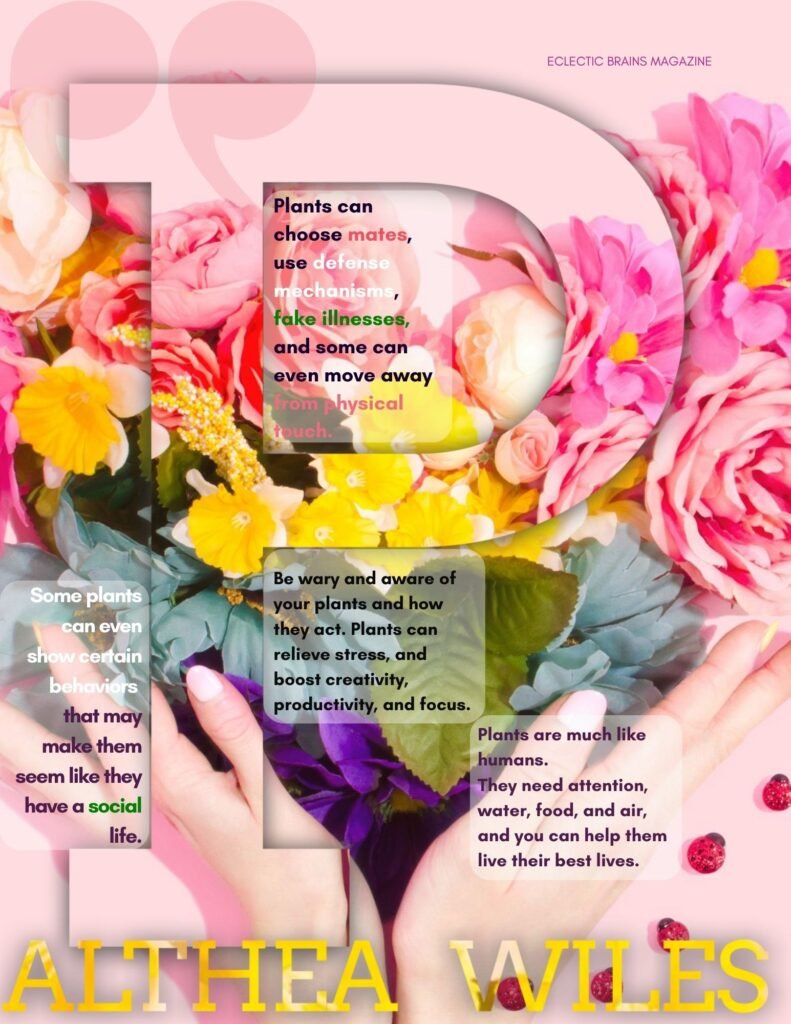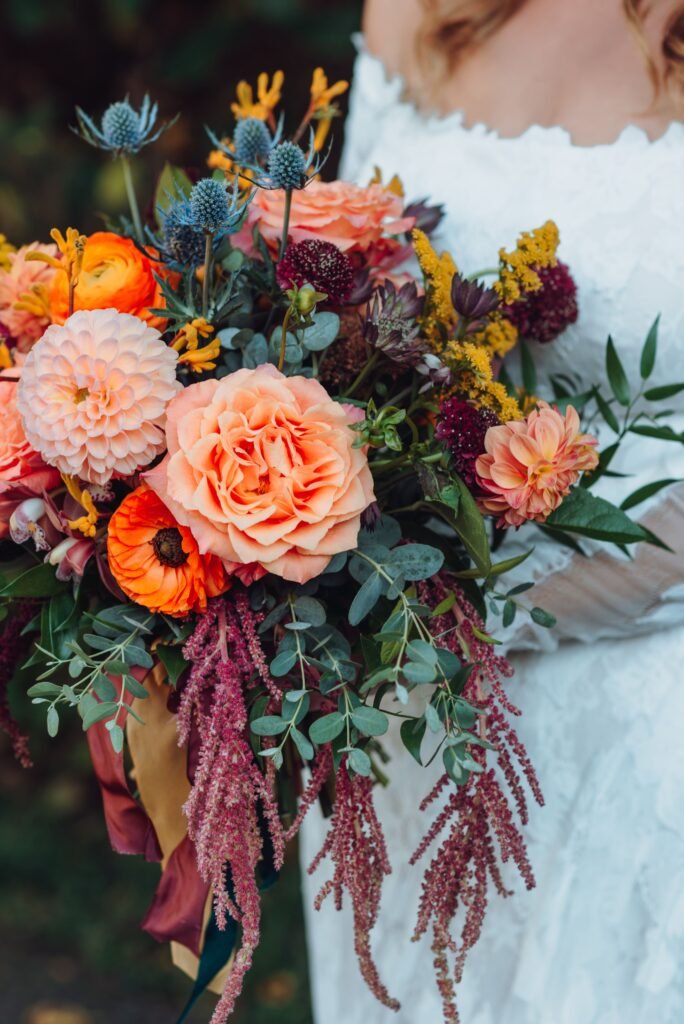SPOTLIGHT : ALTHEA WILES
Owner and Creative Director of Rose of Sharon Floral Design Studio
Founder and florist education director of J Althea Creative
Fayetteville, Arkansas

Plants have become a staple of many people’s lives in our modern world. From house plants to gardens, our lavish lilies and green garnishes are not only pretty but provide us with many benefits. They leave us with cleaner and healthier air in our homes and untainted fruits and vegetables in our tummies. It does take time, patience, and an optimistic attitude to be able to watch your plants prosper. These past few years have taught us that we must find outlets for ourselves to keep a positive mindset, and if you think becoming a plant parent is the outlet for you, you must be prepared. Once you have gained knowledge on the topic, it is truly a lifestyle. Being able to sprout your own life in a pot or in your backyard gives you something to look forward to as well as boosts your mood.
My parents owned a wholesale plant nursery when I was a child. I would raid the daylilies and zinnias during the summer months to create arrangements for my family’s house. All of this to say, plants and flowers have been a part of my world my entire life. As the owner and creative director of Rose of Sharon Floral Design Studio and the founder and florist education director of J Althea Creative, I love passing on knowledge to others interested in horticulture.
Things You Should Know
It may seem quite simple when you think about the materials you will need to start nurturing a plant.
SUNLIGHT
Sunlight is the most important thing you need when it comes to planting. So many plants require that warm and bright sunlight to be able to grow, bloom, and flourish, but there are some plants, such as the peace lily, that do well in little to no sunlight.
WATER
Water is also necessary, just like us humans. Water is needed to germinate the seeds and be able to create a sprout before we can even take care of them. If you have a plant that has already been growing, water acts as a medium in which it carries nutrients and plant food. Different types of plants need different levels of water, and it is important to know how much is too much and how much is too little. Experienced gardeners should take on plants such as the vibrant azalea or the tropical orchid, while beginners should take a look at the adaptable aloe plant and the low-maintenance monstera.
SOIL
Soil is the next material that is a must. Different kinds of plants and flowers may require different mixes of types of soil. It is important to do your own kind of research on your plants and discover what they like the best to be able to achieve maximum growth.
MINDSET
Another thing you need to know is how to keep an optimistic mindset. It can be disappointing at times when your plant starts to droop and you’re losing hope. Having that positive mindset will help you learn from your mistakes. A tip for dying or drooping plants: plants that have healthy roots can be repotted or replanted in better conditions and have a chance of blooming again.
Supplies
There are many things that you should pay attention to if you want to keep a perfect plant perfect.
POT
The kind of pot that you plant your flowers, herbs, or fruits in should be taken into account. A succulent plant would prefer a small terracotta pot or even ceramic. The porous material of the terracotta or clay slowly soaks up the water while the roots still get enough water without getting waterlogged. This kind of pot also encourages air circulation, which allows the plant to breathe, much like a human. An orchid, on the other hand, would much prefer a plastic and shallow pot with drainage holes to ensure it doesn’t get too soggy or wet.
FERTILIZER
If you are planning on planting your plants outside or using soil from the outside for your indoor plants, you may want to consider getting some fertilizer. Not all soil from the ground has enough nutrients for your plants. Plants require nutrients such as nitrogen, potassium, and phosphorus. There are a few others that can be added in small quantities, but they are not necessary. Fertilizing can promote growth, creating bigger and brighter blooms and food. Be careful, though! Overfertilizing can lead to the decay of a plant.
PESTICIDES
With brighter blooms and bigger food, though, come pests. If your gardens or plants are attracting bugs and insects you don’t want around, pesticide may be something you want to invest in. It’s not the best method to use; it can be toxic to animals and even humans, but sometimes it may be the only option.
TIPS
Some tips and tricks to keep the pests away:
- Keep bird feeders nearby. Birds tend to snack on ticks, hornworms, and other various pesky beetles.
- Garden lime can be used as an essential tool to get rid of some species of pests.
- Putting 2 teaspoons of dish soap into a spray bottle of warm water can act as a natural pest eliminator, mostly for indoor plants.
- Onions can be used as a natural repellant due to the smell and sting.
- Different types of soil may be something you want to keep on hand as well. Different types of plants might require different types of soil mixes with different types of nutrients. It is best to do your research before selecting what kind of soil you may want to use for your plants.
Easiest Plants To Grow For Beginners
- SPIDER PLANT
About
The spider plant is very adaptable and is considered one of the easiest houseplants to take care of. It is a perfect plant for beginner gardeners, especially if you are considering indoor plants.
Materials:
-Plastic pot with plenty of drainage holes, a little bigger than the roots
-Moderate to a bright room with a comfortable temperature
-Houseplant fertilizer
-Distilled water or rainwater
How To
Place your plant with the roots ¾ of the way into the soil, with around 1 inch of the pot left unfilled with soil. Thoroughly water the plant and let it drain after potting, then place it in a moderately bright room. To know when to water this plant, you can reach your finger into the soil and see if you can still feel the moisture. If the top one inch of the plant is no longer moist, it’s time to rewater, usually once a week. A month after potting your plant, you may want to start feeding or fertilizing it. Fertilizing or feeding every two to three weeks with houseplant fertilizer would be wise and result in the best for your plant. Common problems to look out for are browning of the leaves, which is a sign of over and under-watering.
- ALOE VERA
About
The aloe vera plant has many benefits for your skin, hair, and body. This plant has antioxidants as well as antibacterial properties that can be used to treat wounds.
Materials:
-Terracotta pot, about 2 inches wider than the plant
-A bright room that gets around 6 hours of sunlight a day
-Phosphorus-heavy fertilizer (optional)
-Distilled water or rainwater
How To
When potting your plant, it would be best to use cactus or succulent soil, since the aloe vera plant is considered succulent. Fill your pot about ⅓ of the way, and then place your plant in and fill it up with soil around the roots until there’s about ¾ of an inch left unfilled. Once your plant has been potted, you can leave it alone for about a week before needing to water it. Aloe is a very simple plant and is great for people who can be forgetful when it comes to watering their plants. When watering your aloe, you will want all of the soil to be entirely moist and let it all dry out before watering again. This will lead to waiting about two to three weeks before needing to water it every time. The aloe plant also does not necessarily need to be fertilized, but if you would like to, fertilizing once a year will be enough. The most common problem with aloe vera plants is root rot. This happens when the roots have been overwatered. To avoid this, make sure you are waiting until the soil has dried out before watering again.
- PEACE LILY
Materials:
-Ceramic or clay pot with at least one drainage hole, about 10 in big.
-Any room with low to bright sunlight
-Houseplant fertilizer
-Distilled water or rainwater
How To:
Peace lilies are known as the closet plants since they do not need very much sunlight and are very popular plants for offices and classrooms. When planting your peace lily, fill your pot ⅓ of the way before placing your root bulb in. Then fill it up with about ¾ of an inch of space until the rim. Peace lilies enjoy being watered often. They like to stay moist, but definitely not drenched. If the top inch of soil around the peace lily is dry, it might be time to water. It’s better to not have a scheduled time every week and just check up on it every day. Peace lilies do not require much fertilizing. About one to two times a year with houseplant fertilizer would be sufficient. Peace lilies can grow to be big plants sometimes when taken care of properly. It benefits the plants to be repotted once they have seemingly outgrown their current pot. Peace lilies can also collect a lot of dust, so be sure you are wiping off their leaves every now and then to prevent any harm from the dust. The most common problem with these kinds of plants is when they outgrow their pots. It can be hard to tell if a plant has outgrown its pot. To be able to spot this, look at the leaf growth. If it looks crowded and if the leaves are growing a bit deformed, it may be time to re-pot.
Plants Are A Lot Like Us.
Plants need water, food, and air to be able to survive. To be the best plant parent you can be, learn about your plant, pay attention to it, and learn from your mistakes. Be aware of your environment. How much sunlight do you get? Do you have pets that could accidentally harm your pot or themselves? Is it too cold or too hot in your house? Many factors can affect the growth of your plants, and each one is special and unique, just like us. Some plants can even show certain behaviors that may make them seem like they have a social life. Plants can choose mates, use defense mechanisms, fake illnesses, and some can even move away from physical touch. Be wary and aware of your plants and how they act. Plants can relieve stress, and boost creativity, productivity, and focus; there’s almost no reason you shouldn’t test out your green thumb! Plants are much like humans. They need attention, water, food, and air, and you can help them live their best lives. “After women, flowers are the most divine creations.” Christian Dior

About Althea:
Althea Wiles is the owner and creative director of Rose of Sharon Floral Design Studio in Fayetteville, Arkansas. She is also the founder and education director of J Althea Creative, a floral design course and florist consulting program. Althea earned her Bachelor of Arts degree from Hendrix College and then completed her Arkansas Master Florist Certification. Her design studio takes part in 75-100 weddings and events annually and has been recognized by publications such as Arkansas Bride as well as being a featured artist for the Art in Bloom gallery exhibit chosen and hosted by the Crystal Bridges Museum of American Art.
Althea Wiles recently curated a collection of live floral fashion accessories in the form of necklaces, anklets, bracelets, rings, hair clips, handbag clips, and a host of other fabulous embellishments. Men and women can be inspired by nature’s beauty in the search for fashionable adornments appropriate for any occasion. These living pieces of art make great conversation starters on outings in addition to fashion statements. Living floral accessories can be designed in similar materials for custom-style sets. These pieces are beautifully packaged for gifting, especially to your significant other for a fun night out on the town. By utilising what is available at local farms, these designs can also be a sustainable product and an alternative to traditional pieces of jewelry.



IMAGES © ALTHEA WILES
PR : Meredith Corning










